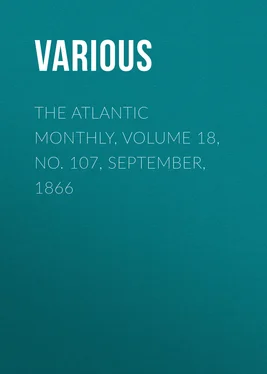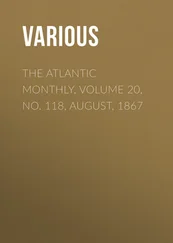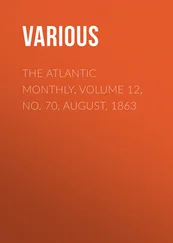Various - The Atlantic Monthly, Volume 18, No. 107, September, 1866
Здесь есть возможность читать онлайн «Various - The Atlantic Monthly, Volume 18, No. 107, September, 1866» — ознакомительный отрывок электронной книги совершенно бесплатно, а после прочтения отрывка купить полную версию. В некоторых случаях можно слушать аудио, скачать через торрент в формате fb2 и присутствует краткое содержание. Жанр: foreign_antique, periodic, foreign_edu, на английском языке. Описание произведения, (предисловие) а так же отзывы посетителей доступны на портале библиотеки ЛибКат.
- Название:The Atlantic Monthly, Volume 18, No. 107, September, 1866
- Автор:
- Жанр:
- Год:неизвестен
- ISBN:нет данных
- Рейтинг книги:4 / 5. Голосов: 1
-
Избранное:Добавить в избранное
- Отзывы:
-
Ваша оценка:
- 80
- 1
- 2
- 3
- 4
- 5
The Atlantic Monthly, Volume 18, No. 107, September, 1866: краткое содержание, описание и аннотация
Предлагаем к чтению аннотацию, описание, краткое содержание или предисловие (зависит от того, что написал сам автор книги «The Atlantic Monthly, Volume 18, No. 107, September, 1866»). Если вы не нашли необходимую информацию о книге — напишите в комментариях, мы постараемся отыскать её.
The Atlantic Monthly, Volume 18, No. 107, September, 1866 — читать онлайн ознакомительный отрывок
Ниже представлен текст книги, разбитый по страницам. Система сохранения места последней прочитанной страницы, позволяет с удобством читать онлайн бесплатно книгу «The Atlantic Monthly, Volume 18, No. 107, September, 1866», без необходимости каждый раз заново искать на чём Вы остановились. Поставьте закладку, и сможете в любой момент перейти на страницу, на которой закончили чтение.
Интервал:
Закладка:
Christine's style of holding the implements,—one in each hand,—and the case of materials for her work which lies beside her, are according to representations of the miniatori caligrafi at their labors; and, as the art of caligraphy was well known at Bologna, so learned a man as Thomas de Pisan must have been acquainted with it, and would have caused his talented daughter to be instructed in so rare an accomplishment. It is not therefore unreasonable to believe that, in the beautiful volume now in the British Museum, the work of Christine's hand, as well as the result of her genius, is preserved. The next picture shows us Christine presenting her book to Charles VII. of France, who is dressed in a black robe edged with ermine; he wears a golden belt, order, and crown. The king is seated beneath a canopy, blue, powdered with fleurs de lis . Four courtiers stand beside him, dressed in robes of different colors,—one in pink, and wearing a large white hat of Quaker-like fashion. Christine has put on a white robe over her blue dress, perhaps as a sign of mourning,—she being then a widow. A white veil depends from the peaks of her head-dress. She kneels before the king, and presents her book.
Another and more elaborate picture represents the repetition of the same ceremony before Isabelle of Bavaria, queen of Charles VI. We are here admitted into the private royal apartments of the fourteenth century. The hangings of the apartment consist of strips, upon which are alternately emblazoned the armorial devices of France and Bavaria. A couch or bed, with a square canopy covered with red and blue, having the royal arms embroidered in the centre, stands on one side of the room. The queen is seated upon a lounge of modern shape, covered to correspond with the couch. She is dressed in a splendid robe of purple and gold, with long sleeves sweeping the ground, lined with ermine; upon her head arises a structure of stuffed rolls, heavy in material and covered with jewels, which shoots up into two high peaks above her forehead. Six ladies are in waiting, two in black and gold, with the same enormous head-gears. They sit on the edge of her Majesty's sofa, while four ladies of inferior rank and plainer garments are contented with low benches. Christine reappears in her blue dress, and white-veiled, peaked cap. She kneels before the queen, on a square carpet with a geometrical-patterned border, and presents her book. A white Italian hound lies at the foot of the couch, while beside Isabelle sits a small white dog, resembling the one we saw in Christine's study. As we can hardly suppose Christine would bring her pet on so solemn an occasion,—far less allow him to jump up beside the queen,—and as this little animal wears no gold bells, we are led to suppose that little white dogs were in fashion in the fourteenth century.
We cannot say that the portrait of Isabelle gives us any idea of her splendid beauty; but "handsome is that handsome does," and as Isabelle's work was a very bad one in the Middle Ages, we will say no more about her.
Christine was but twenty-five years of age when she became a widow, and her personal charms captivated the heart of no less a personage than the Earl of Salisbury, who came ambassador from England to demand the hand of the very youthful princess, Isabelle, for his master.
They exchanged verses; and although Salisbury spoke by no means mysteriously, the sage Christine affected to view his declarations only in the light of complimentary speeches from a gallant knight. The Earl considered himself as rejected, bade adieu to love, and renounced marriage. To Christine he made a very singular proposal for a rejected lover,—that of taking with him to England her eldest son, promising to devote himself to his education and preferment. The offer was too valuable to be declined by a poor widow, whose pen was her only means of supporting her family. That such a proof of devotion argued a tenderer feeling than that of knightly gallantry must have been apparent to Christine; but for reasons best understood by herself,—and shall we not believe with a heart yet true to her husband's memory?—she merely acknowledged the kindness shown to her son; and the Earl and his adopted boy left France together. When Richard II. was deposed, Henry Bolingbroke struck off the head of the Earl of Salisbury. Among the papers of the murdered man the lays of Christine were found by King Henry, who was so much struck with their purity and beauty, that he wrote to the fair authoress of her son's safety, under his protection, and invited her to his court.
This invitation was at once a compliment and an insult, for the hand that sent it was stained with the blood of her friend. Christine, however, had worldly wisdom enough to send a respectful, though firm refusal, to a crowned head, a successful soldier, and one, moreover, who held her son in his power. Feminine tact must have guided her pen, for Henry was not offended, and twice despatched a herald to renew the invitation to his court. She steadily declined to leave France, but managed the affair so admirably that she at last obtained the return of her son from England.
Like her father, Thomas de Pisan, Christine seems to have been sought as an ornament of their courts by several rulers. Henry Bolingbroke could not gain her for England, and the Duke of Milan in vain urged her to reside in that city. Seldom has a literary lady in any age received such tempting invitations; yet Christine refused to leave France, although her own fortunes were anything but certain. The Duke of Burgundy took her son under his protection, and urged Christine to write the history of her patron, Charles V. of France. This was a work grateful to her feelings, and she had commenced the memoir when the death of the Duke deprived her of his patronage, and threw her son again upon her care, involving her in many anxieties. But Christine bore herself through all her trials with firmness and prudence, and her latter days were more tranquil. She took a deep interest in the affairs of her adopted country, and welcomed in her writings the appearance of the Maid of Orleans. We believe, however, that she was spared the pain of witnessing the last act in that drama of history, where an innocent victim was given up by French perfidy to English cruelty.
The deeds of Joan of Arc need no recital here. A daughter of France in the nineteenth century had a soul pure enough to reflect the image of the Maid of Orleans, and with a skilful hand she embodied the vision in marble. The statue of Joan of Arc, modelled by the Princess Marie, adorns—or rather sanctifies—the halls of Versailles.
Of woman's work as an artist in the early centuries we have a curious illustration in a manuscript belonging to the Bibliothèque Royale at Paris, which exhibits a female figure painting the statue of the Madonna. The artist holds in her left hand a palette, which is the earliest notice of the use of that implement with which antiquarians are acquainted. The fashion of painting figures cut in wood was once much practised, and we see here the representation of a female artist of very ancient date. Painting, music, and dancing come under the designation of accomplishments; yet to obtain distinction in any of these branches implies a vast amount of work. An illustration of Lygate's Pilgrim shows us a young lady playing upon a species of organ with one hand; in the other she holds to her lips a mellow horn, through which she pours her breath, if not her soul; lying beside her is a stringed instrument called a sawtry. Such varied musical acquirements certainly argue both industry and devotion to art. Charlemagne's daughters were distinguished for their skill in dancing; and we read of many instances in the Middle Ages of women excelling in these fine arts.
The period of time generally denominated the Middle Ages commences with the fifth century, and ends with the fifteenth. We have in several instances ventured to extend the limits as far as a part of the sixteenth century, and therefore include among female artists the name of Sofonisba Anguisciola, who was born about 1540. She was a noble lady of Cremona, whose fame spread early throughout Italy. In 1559, Philip II. of Spain invited her to his court at Madrid, where on her arrival she was treated with great distinction. Her chief study was portraiture, and her pictures became objects of great value to kings and popes.
Читать дальшеИнтервал:
Закладка:
Похожие книги на «The Atlantic Monthly, Volume 18, No. 107, September, 1866»
Представляем Вашему вниманию похожие книги на «The Atlantic Monthly, Volume 18, No. 107, September, 1866» списком для выбора. Мы отобрали схожую по названию и смыслу литературу в надежде предоставить читателям больше вариантов отыскать новые, интересные, ещё непрочитанные произведения.
Обсуждение, отзывы о книге «The Atlantic Monthly, Volume 18, No. 107, September, 1866» и просто собственные мнения читателей. Оставьте ваши комментарии, напишите, что Вы думаете о произведении, его смысле или главных героях. Укажите что конкретно понравилось, а что нет, и почему Вы так считаете.












